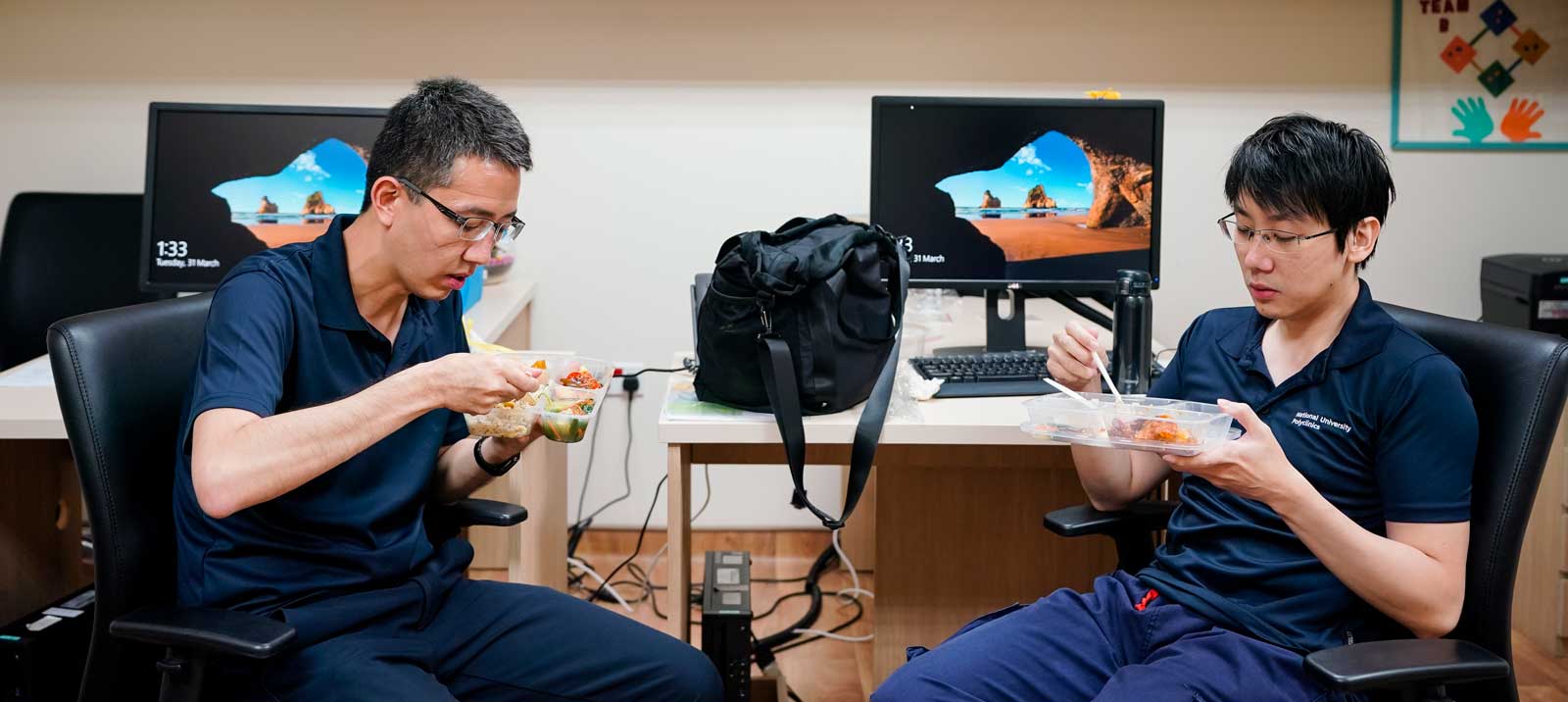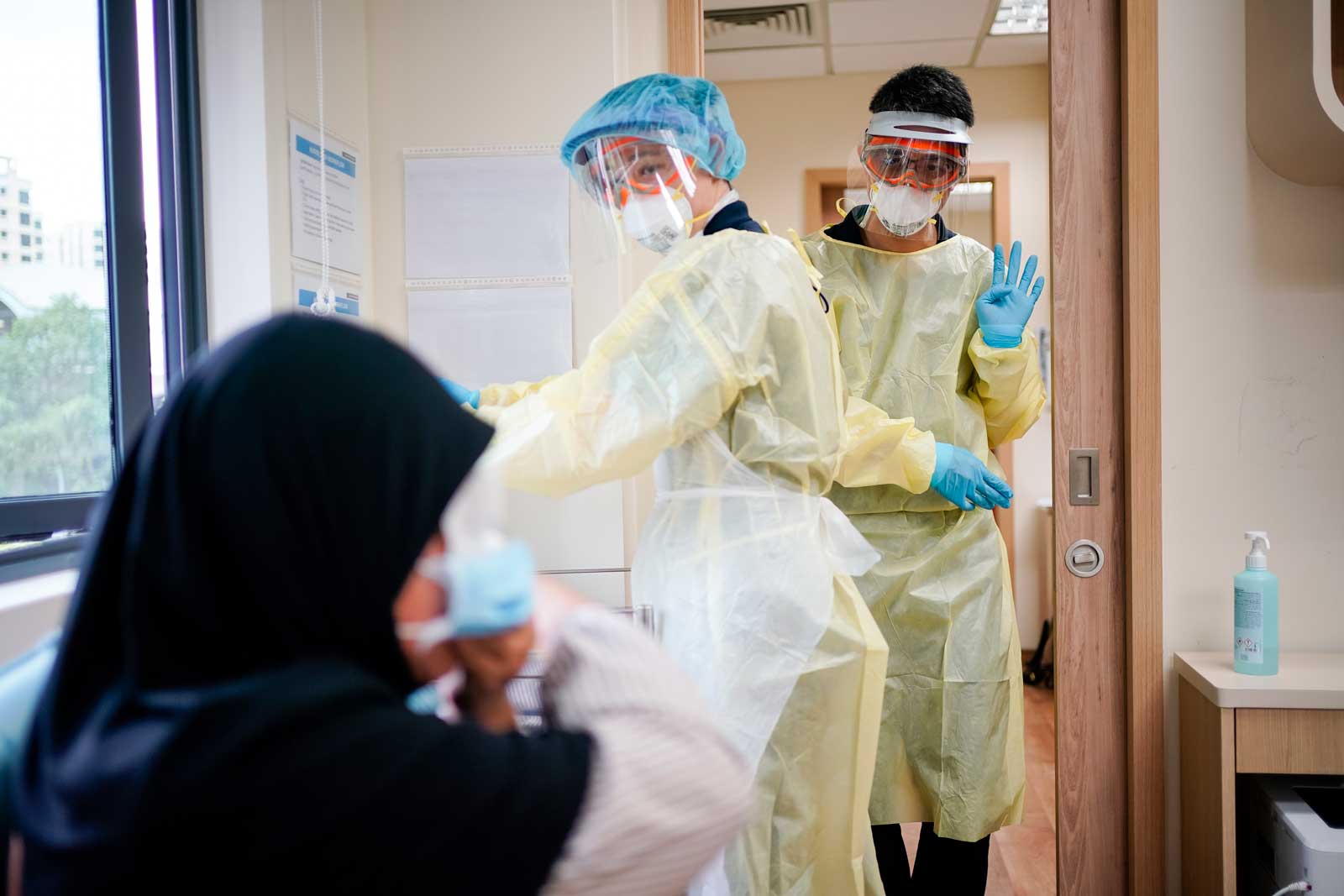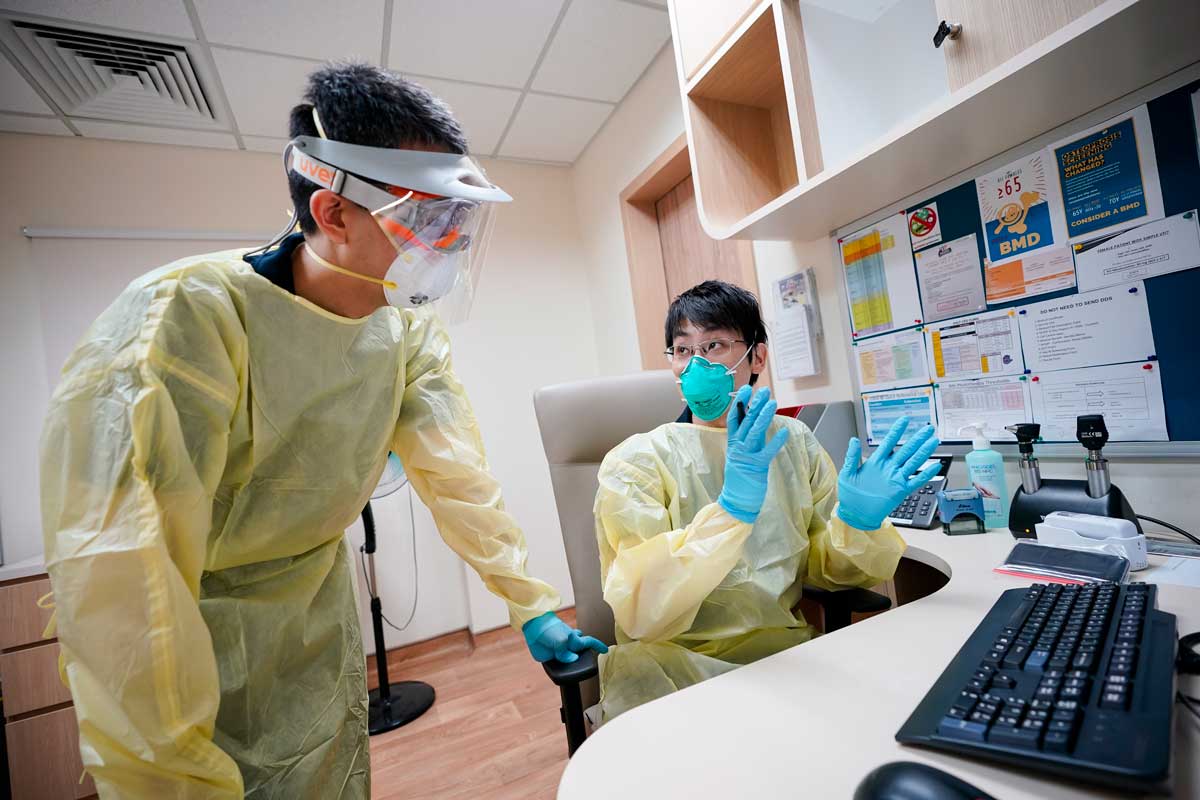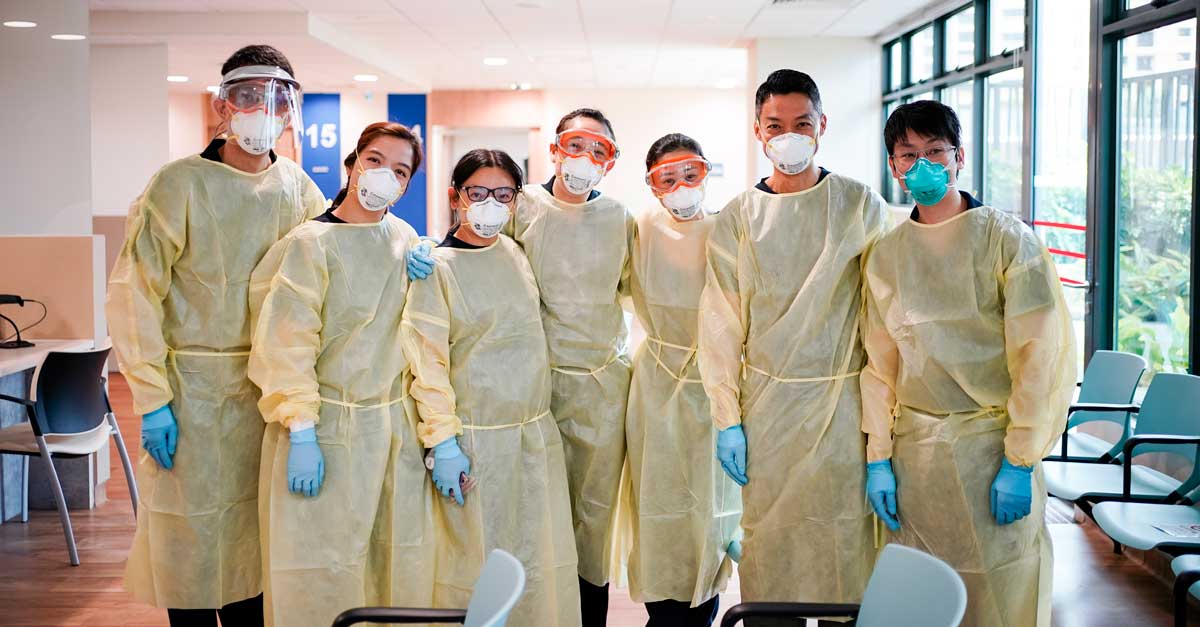Dispatch From The Front

Dr Chua Ying Xian examining a patient with flu symptoms in the fever zone. Photo credit: National University Polyclinics
by Dr Chua Ying Xian and Dr Lawrence Lam Teck Meng
Family Physicians, NUHS
NOT YOUR SUPERHERO
“This is the fight of our lives. We are going to win. Whatever it takes.”
Steve Rogers, or better known as Captain America, said this to the Avengers before they had the exigent yet perilous task of retrieving the Infinity Stones in their bid to reverse the catastrophe. That battle cry was what kept the team going, and can we say the same for the current Covid-19 pandemic?
The outbreak’s focus, which had shifted from China to Europe, had claimed more than 50,000 lives with more than a million infected at the time of writing, with countries shutting off their borders frantically from mid-March in a desperate effort to put a brake on the contagion. Physicians around the world had started to share harrowing experiences in various media, from being overwhelmed by the sheer volume of patients streaming in the already overloaded healthcare facilities, to being ostracised by members of the public. People are looking for reliable information and physician leaders want accurate and actionable messages to reach the public.
As a frontline family physician, it has never been more daunting to deliver care for my patients during this pandemic. Through sweat- soaked clothes and personal protective gear, my team of frontline healthcare providers worked tirelessly to differentiate the higher- risk patients from those who had a relatively minor non-COVID-19 infection. From pre-triage screening workflows to appropriate segregation of patients, patients are sent to designated zones for their consults.
Each morning, the team of doctors will huddle for a short discussion, going through countless iterations of revised workflows, updated case definitions and suspect cases’ swab results from the day before. About 30% of all clinic attendances are seen by the fever sector during a working week. This will include patients who present with any respiratory symptoms, had declared a significant travel history, and are under stay-home notices or phone surveillance by Ministry of Health officers. This translates to each of us seeing up to eight patients per hour on a busy day.

Dr Chua Ying Xian (left) and Dr Lawrence Lam having a quick lunch (and break) after seeing patients in the morning
Lunch breaks and continuing medical education sessions are held in separate zones for fever zone family physicians. Each day ends with a chafed face and an exhausted mind. Photos of health-care workers unmasked after each shift started circulating on social media, leaving a lasting and palpable image to all.
To top it all, each patient coming through the door poses its own challenges in a pandemic. A low-grade fever and cough might no longer be just an everyday “common cold”. Having studied the symptomatology of patients suffering from the novel coronavirus and with five of them passing through our doors earlier on in the outbreak, accurate identification is indeed not a walk in the park. While a large majority of them presented with fever, not all present with florid respiratory symptoms. Two had initial presentation of lower urinary tract symptoms, and another had clinical and biochemical resemblance to dengue infection, which eventually was diagnosed as a false positive dengue infection.
The work doesn’t end when the clinic pulls its shutters down. Each time the phone beeps signifying a new message, I squirmed, glancing at the title of the messages. Local news with updated workflow is being disseminated at breakneck speed. One has hardly time to fully digest information before the next update pops up. And before I know it, it’s dawn again, and time to head back to the clinic.

Dr Chua checking on his patient after the swab is done
IS IT WHAT IT IS?
I still remember the consultation with our first confirmed case vividly. This patient presented to us with six days of a fever and cough developing, having already been seen at the Emergency department. He tested negative for dengue and was discharged. As the clinic where I am practicing is surrounded by dengue hotspots, and as his fever was persistent, I repeated his blood count. It was strangely still suspicious of dengue. In view of the growing numbers of COVID-19 infection, naturally the patient and his wife were worried about it. As they had no significant travel or sick contact history, we decided to review the patient the next day for reassessment. When he returned, the follow-up blood test showed worsening platelet counts which was consistent with dengue fever. But something was amiss when he said “I am feeling a little more breathless today. Is this part of dengue?”
He had developed an uncommon symptom not quite consistent with dengue. As family physicians, we rely on both our knowledge of outbreak epidemiology along with good history taking and understanding of disease patterns to determine diagnostic probabilities. However, now we were faced with a clinical dilemma as well as onflicting symptoms and laboratory investigations. Dengue fever does not cause cough or shortness of breath usually. Low platelet count was not a common feature of COVID-19 infections either. We knew that we had done what we could in primary care and this patient needed further work- up and investigations.
“Dengue doesn’t usually present this way. Let’s send you to the hospital for further checks, alright?”
We decided to refer him to the hospital. When we found out the next day about the confirmed COVID-19 diagnosis, we had mixed feelings. Of course, we were worried about getting the infection, as well as all our staff and patients who came in close contact with the him. I texted my wife immediately and asked if she wanted to stay with her parents for a fortnight, just to be on the safe side. Numerous messages of concern from family and friends started pouring in. Irrational doubts crossed through my mind the next couple of days. Did I scratch my face after I saw the patient? Was my mask properly fitted? Why is my throat so itchy? Am I… infected?
The fear is real. The concerns are legitimate.
“PLEASE DON’T COME TOO NEAR ME”
It broke my heart when a patient said that and frantically gestured when I was about to examine him. “I think I am infected; I have been staying with a confirmed patient!” exclaimed the young man. “It is OK. I will still examine you. You are under my care. Don’t worry, you can see I am wearing my protective gear.” My words somewhat reassured him as he sat gingerly at the edge of the chair. “Thank you for being kind. Everyone at home is avoiding me like a parasite since I started coughing.” He replied softly. I can sense the sadness in his voice, and on any other day, I would have given him a gentle reassuring pat on his shoulder. That day, I held back. I knew it is the correct thing to do, to minimise duration and physical contact time, yet a wave of guilt overwhelmed me.
“HEY, I AM HAVING A COUGH AND FEVER”
It is the last thing you want to hear when various staff from different departments come over and report sick. In full gear, I examined a few of them, before they posed a very difficult question, “Dr, do you think I might be infected?” These colleagues have been serving and coming into direct contact with the confirmed cases in our clinic. Though most have been attending to the patients in their full protective gear, there’s still this fear that they might be infected. I have the very difficult task of treating them, arranging for swabs to be performed and yet extending words of comfort while asking them to continue to observe the necessary precautionary measures. Through these consults, I told myself to remain composed and appear fearless, for the battle isn’t just a physical one, but a psychological test as well. The staff needed assurance, and I as a team member, must provide them with that.

Dr Lawrence Lam (right) and Dr Chua Ying Xian discussing patient cases
AND WE STICK TOGETHER
“What should I do? I just found out my patient was a confirmed case!” On more than one occasion, I received texts from my private General Practitioner (GP) colleagues. Awestruck, I quickly learnt that it was not fear of acquiring the infection, but the immediate concerns they had for the rest of the patients who were within the clinic vicinity of the confirmed case. Discussions on contact tracing, living apart from their family members became dominant topics, while minimizing attending social events become the new normal. Yes, the pandemic has forced many to practice social distancing. But it has also afforded opportunities to communicate best practices, share our struggles, and even talk about what’s left of our social life.
AS THE EVENING COMES
I enter the de-gowning room as the clinic sees the last few patients step out. I disinfect my stethoscope, pulse oximeter and discard the soaked PPE. Peering out of the window, I can see the evening glow in the distance. The familiar faint rumbling of the train and people walking in the distant restored some sense of normalcy. Washing my face, checking the pressure marks on my face and nose, I returned to my desk to attend to outstanding emails and work on my lectures, which I am scheduled to give to both post and undergraduate medical students.
“PART OF THE JOURNEY IS THE END”
There’s much hype about heroes without capes. I will take a slightly different stand. Superheroes do not fear, we doctors and nurses do. Superheroes do not faint, doctors and nurses do. Superheroes do not weep, doctors and nurses do.
I am not a superhero. I am your primary care doctor. And to my fellow colleagues who stand united and bravely at the frontline – as Tony Stark would put it – part of the journey is the end.
The role of primary care in fighting this pandemic was to triage and identify suspect cases, reassure the public and promote social responsibility to reduce up-trending community transmission. Everyone has a role to play in this fight. We know that this will be a drawn-out war, and we will push on, one patient at a time.
There will be light at the end of the tunnel. But till then, I will be in my gear, ready for the next challenge.

Working together as a team for the well-being of the patients and community
